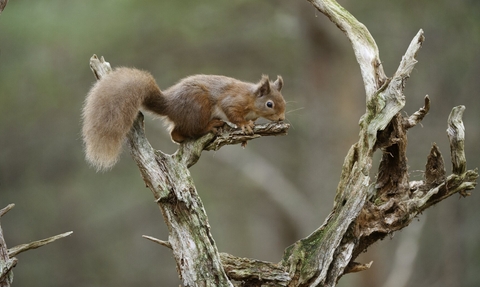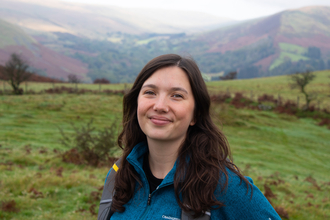
Red squirrel (Sciurus vulgaris) on old pine stump in woodland, Scotland, November - Mark Hamblin/2020VISION
Red Squirrel Research
Genetic Research
During three survey periods a targeted trapping programme under licence resulted in a number of Red squirrels being trapped. DNA analysis revealed five different mitochondrial DNA haplotypes within the Mid Wales population.
A haplotype is a genetic marker that can provide useful information on the genetic make-up and ancestry of a population of a particular species
From the Mid Wales Red squirrel population three of the five haplotypes had been previously recorded in Wales, however this was the first time their presence had been recorded within a single locality.
Three of the haplotypes appear to be unique to the Mid Wales population. In 2013, a new haplotype was identified in the Mid Wales population in a study carried out by the MISE project.
This haplotype is thought to have derived from British translocations in the past, given that it was found in a British museum specimen. It is currently the most common haplotype in Red squirrels in Ireland, however it had not previously been recorded in any surviving Red squirrel population in Britain.
The results of genetic analysis have revealed that the Red squirrel population in Mid Wales has large genetic variation. This has implications for both the conservation of the local population and the conservation of Red squirrels in Wales as a whole. If there is a large genetic variation within a population conservation attempts are more likely to prove successful.
Habitat Surveys
To ensure suitable habitat for Red squirrels in Mid Wales, forest management in the Mid Wales Red Squirrel Focal Area must be addressed.
The Partnership works with forest managers to try to maintain and improve habitat which is suitable for red squirrels as well as maintaining connectivity between these forest areas.
In order to safeguard the Red squirrel population in the Focal Site it is important that there is sufficient feeding habitat for Red squirrels whilst not encouraging grey squirrels. It has been shown that even 1% of broadleaves in a conifer woodland is enough to maintain a population of greys. Large-seeded trees such as oak, beech and hazel must be kept to a minimum in these areas, preferred broadleaved species are birch, willow and alder.
In coniferous forests, Red squirrels prefer to feed on large-seeded conifers, primarily lodgepole pine, Norway spruce and larch. Patches of good feeding habitat are needed within a wider matrix of lower quality habitat such as Sitka spruce.
Forest connectivity needs to be maintained between these Key Areas throughout the felling cycles to enable movement of red squirrels. In 2012 the Mid Wales Red Squirrel Partnership commissioned a habitat survey of the Mid Wales Red squirrel focal area – Developing an understanding of forest management requirements for Red squirrels in Mid-Wales Focal Site. The survey assessed and mapped the location, extent and quality of habitat suitable for Red squirrels and assessed arboreal connectivity between key areas. Essentially, the report provides recommendations for maintaining and enhancing key areas and arboreal connectivity.
In 2017 the Wildlife Trust of South and West Wales coordinated the creation of a 5-year Management Plan for the Mid Wales Red Squirrel Focal Site on behalf of the Mid Wales Red Squirrel Partnership. The Plan, ‘Optimising Habitat Management for Red Squirrels‘ is a collaboration between the Wildlife Trust of South and West Wales, private forestry companies and Natural Resources Wales.
Whilst acknowledging that forest managers have other, sometimes conflicting, management objectives, the Partnership works to ensure that recommendations are followed by as many forestry managers as possible and that the Tywi Forest has Red squirrel conservation as one of its major objectives for future forest management.
Supporting Students
If you are an undergraduate or postgraduate student and are interested in carrying out a research project, we can help support you. Please note that we do not currently have a list of specific project ideas but if you already have a project idea in mind, please contact info@welshwildlife.org (with Red Squirrel Research Project as the subject) to discuss whether your ideas are feasible. Please note that you will be expected to provide a detail project plan prior to conducting any projects and to cover any associated costs involved.
Research in a Nutshell
Over the last year, two master’s students from Nottingham Trent University utilised our historical data for their research projects. Read a summary of their research below.


